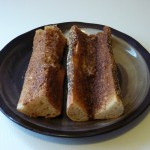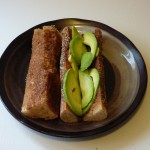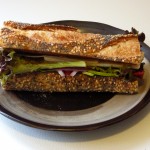We were introduced to socca, a vegan and gluten-free flatbread, by Mike Dash of Rolling Fire when we took a class on wood-fired cooking through the Experimental College. Mike has been tuning his recipe for years, adjusting the ratios of ingredients, trying special pans, adjusting resting times, and the like. His socca is delicious: creamy and eggy on the inside, crispy and crunchy on the edges, and perfectly balanced in its seasoning.
It’s also only available once a week when he’s at the farmers’ market, and not at all during his off season.
Happily, The Minimalist is right:
I’ve eaten and made both socca and farinata in Nice and in Genoa, and I’ve made it at home a hundred times. It is foolproof and 90 percent as good made in your oven as when whisked from the wood-burning ovens of Nice to the street stands in the market. It’s so simple and its flavors are so pure that unless you buy rancid chickpea flour you will get it right the first try.
Socca made at home from this recipe is merely very good, not transcendent like Mike’s. But that’s good enough for me.
Ingredients:
- 1 cup (120g) garbanzo/chickpea flour (I use Bob’s Red Mill
, but would like to try grinding my own)
- 1 cup (227g) water
- 2 tablespoons olive oil
- 1 teaspoon freshly ground pepper (about 100 turns on the grinder we have)
- about 1/2 teaspoon of kosher salt, maybe a little more
Whisk all the ingredients together in something you can pour them out of easily; I use a 2-cup pyrex measuring cup. You don’t want any lumps. Set the mixture aside, not in the refrigerator. Ideally, do this several hours before you’re going to actually cook it; I believe that letting it sit for a while to hydrate will lead to a creamier consistency in the final result. But I haven’t actually tested this, since by the time I’m putting together the batter, I want socca as soon as possible.
Anyway, once you have the batter mixture put together, set your oven racks to the middle and high positions if you have two; just the high if you only have one. Put a 12 inch cast iron pan on the rack and set the oven for 450 degrees. I’m using a Lodge 10-1/2-inch round griddle, which makes for a thicker socca than the 12-inch pan the Minimalist recipe calls for. I like it a bit thick, so that works for me. Once your oven has reached 450 degrees, set a timer for 10 minutes and leave the pan in there to get good and hot.
After the pan is hot, take it out and swirl some oil in it (maybe a tablespoon? I never measure), making sure the entire pan is coated. Set the pan back down on the stove and pour the batter in from the center. It should sizzle and push the oil out to the edges. Carefully put the pan back in the oven, and set the timer for 12 minutes.
After 12 minutes, brush the top of the socca with some oil if it looks dry, then turn on the broiler and move the pan to the upper rack. Broil the socca for 3 minutes to get a bit of a charred crust around the edges. Take the pan out of the oven and remove the socca with a thin spatula. Cut it into quarters and eat while it’s still hot. Om nom.









